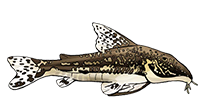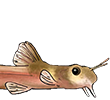https:/doi.org/10.22059/jfisheries.2024.373236.1419
https://jfisheries.ut.ac.ir/article_97815_en.html
Pdf: https://jfisheries.ut.ac.ir/article_978 ... df?lang=en
Keywords: Driftwood catfish, Semi-artificial reproduction, Ornamental fish, Ovulin hormoneAbstract
Driftwood catfish () is a member of the Auchenipteridae family, native to South America and of interest to aquarium enthusiasts. In recent years, this species has been introduced to the ornamental fish market of Iran and popularized under the commercial name Colombian Pangasius. For the first time, this research has introduced the reproductive biology of this species in nature and its unique reproduction in captivity among the valid studies of Persian and English language journals. Ovulin (as a proliferation inducing agent) was injected at a dose of 0.5 ml/kg to 4 female broodstock. Then they were placed in the breeding tank alone without the male breeder. The injected broodstock spawned approximately 21 hours after injection and the eggs were fertilized. About 22,000 eggs were harvested, and on average, 5,000 eggs were obtained from every 100 grams of fertile female. The scientific reasons of this phenomenon were examined in detail along with determining the time of fertilization. Accurate calculation of fertility was difficult and estimated to be around 70% or lower. According to the histological results, it was found that this species is of the Asynchronous or batch spawning type, which can be the cause of this low fertility. The result of this research shows that, firstly, the reproduction of this species in captivity is possible without egg and sperm stripping and artificial insemination, and secondly as an exception case among the majority of ornamental and non-ornamental fishes, its reproduction can be done with females alone without any male for fertilizing the gathered eggs.





